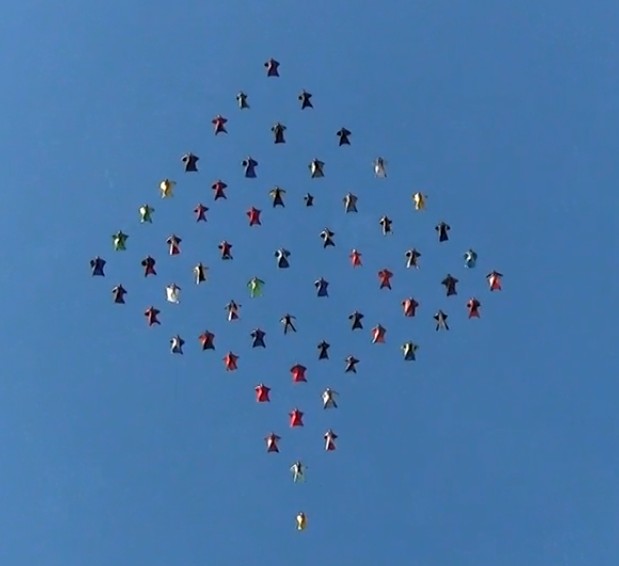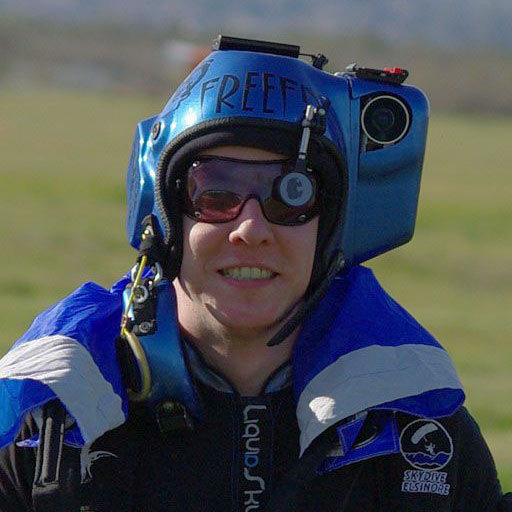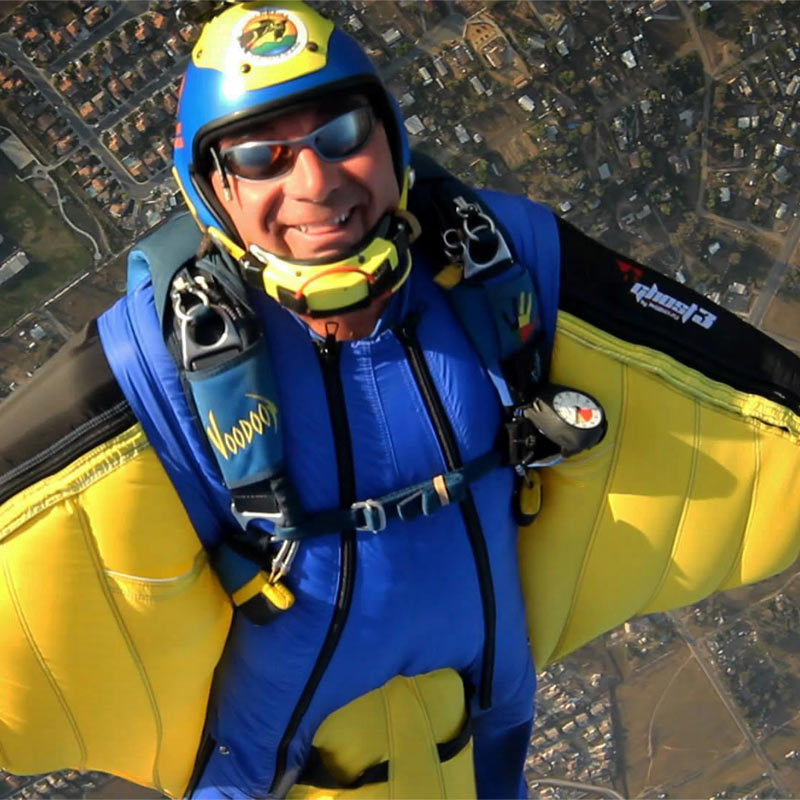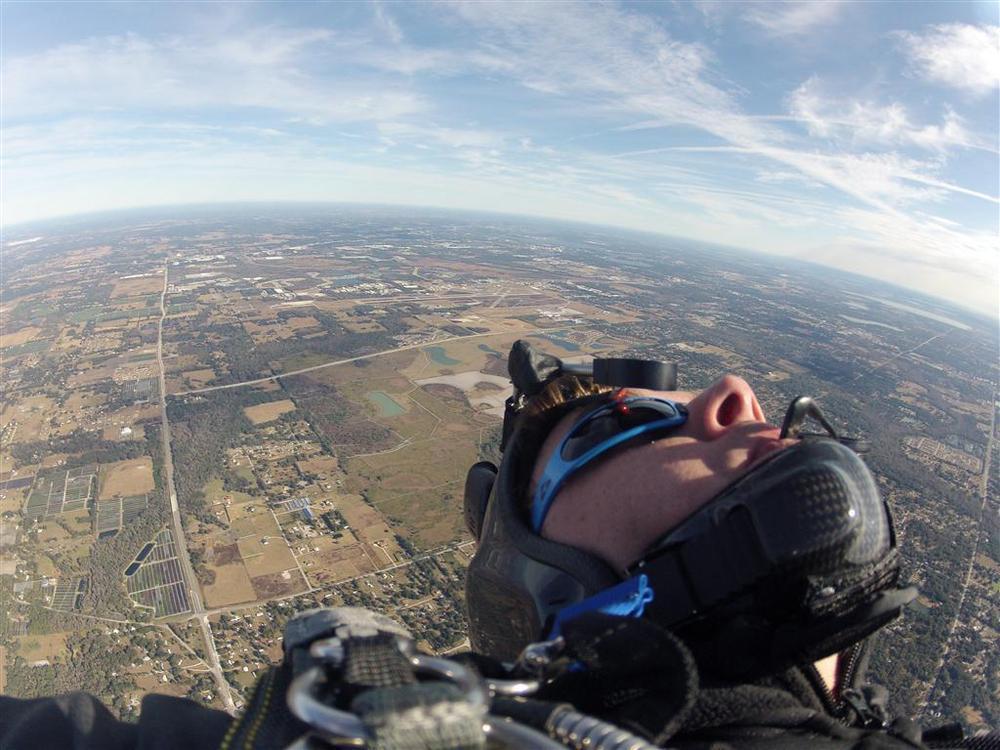Recommended Posts
kallend 2,098
QuoteHow would you go about designing a set of tests to show the ability to focus in an emergency skydiving situation, with the added distraction of a camera?
It's the added distraction that is being questioned, whether it's the camera or the wingsuit.
In the case of swooping, the Billvon list at the previous size might be OK. Of course, that would imply that the student had to make enough jumps to do all that, and had gone through a number of canopy sizes -- but that's probably OK, because he gains experience in a variety of situations that way.
Wendy P.
How do you know that an a 200 jump individual has that ability while a 196 jump person doesn't?
The only sure way to survive a canopy collision is not to have one.
QuoteNot an insurmountable problem.
1. The evaluation is of prior skills. Doesn't even need to be a WS flier to do that, just a checklist like BV's downsizing list.
2. I'd far rather see a WS instructor rating than an arbitrary criterion.
I think most agree that an evaluation against a set of relevant skill and knowledge criteria is better than a minimum experience level. Someone previously mentioned pilot licences and ratings. For example, you can't get a commercial pilot's licence if you only have 50 hours of flying time, regardless of how good your skills are. I can't speak for those who set those rules, but I believe that part of the reason revolves around the idea that to take on the additional responsibilities expected of a commercial pilot, you need a certain level of experience. By the same token, if you have 10000 hours of flight time but fail the practical or written exams required, you also cannot be a commercial pilot.
I think a similar situation exists in many skydiving disciplines. Yes - a rating system based on demonstrated skills and knowledge is definitely a much better yardstick than a preset minimum number of jumps, freefal time or time in sport, but I also think it's reasonable that there should be some minimum recommended limit below which it's highly unlikely that someone will have the necessary experience.
You fill in an appropriate number for whatever discipline you want to talk about.
I guess you were talking about a wingsuit. So. maybe it would be like 450 or 475 or something like that. I wouldn't expect a person with 200 jumps to get the sort of reaction I wrote from a wingsuit coach.
Sorry for the confusion.
QuoteRight now, there is nothing that the 175 jump wonder can do at all to be "on the way".
Yes they can. They can do 25 more jumps. If they're really smart, they could do 25 more jumps focussed on gaining skills that may be transferable to what they want to do. For example, prospective wingsuiters might focus on tracking dives.
QuoteIf people bend them too far, pull or suspend their USPA membership. Then they won't be messing around at USPA dropzones anymore, or at least not for a while.
How will you define what is bending the rules "too much". Somehow you need to have some consistent way of determining what is bending the rules "too much".
QuoteHard rules often just piss people off. Recommendations that can be reasonably adjusted can draw people into the system.
No matter how you think of a BSR, given that the USPA and many other national organisations have no real regulatory power, they really are only recommendations, but having a recommended minimum limit on the books makes it less likely to continually drift down. If you say it's a 200 jump minimum to fly qingsuit or camera, maybe there will be instructors, DZOs and others who may allow it at 175 jumps, but the chance of it drifting down to 100 jumps or 50 jumps is reduced.
billvon 3,057
>jump person doesn't?
You don't. No number will ever be perfect.
How do you know that someone who deploys by 2000 feet is safe, but someone who deploys by 1900 feet isn't? You don't.
How do you know a student will be fine in a 13mph wind but not in a 15mph wind? You don't.
How do you know that a student landing area that's 200 meters across is safe, but one that is 199 meters across isn't? You don't.
How do you know that if your airplane is one pound under max takeoff it's OK, but if it's one pound under max takeoff, it isn't? You don't.
How do you know that repacking your reserve every 175 days means it's good to go, but every 185 days means it is a safety problem? You don't.
In all the above cases, we (meaning USPA, the FAA, the DZO etc) make the best call we can with the information we have. Can you take off overweight, jump your reserve 200 days instead of 180, have a student land safely in a 15mph wind? Sure. Doesn't mean it's a good idea.
Quote
Well, you seem to agree that some hard and fast rules (i.e. you can't wingsuit at 10 jumps) are OK. I guess the challenge is just deciding where that point is.
Recommendations are certainly a good place to start. My questions are primarily regarding the hardness and/or fastness of these recommendations.
I believe we need to allow for some variance from the recommendations to adjust for actual conditions. These variations can work both ways. A candidate might find a mentor a little earlier than the recommended number of jumps, and the mentor might take him past the recommended number of jumps before the actual goal is accomplished. Or, if the mentor has been satisfied that the candidate is ready, they may start doing the actual thing a bit ahead of the recommendation.
The point is that the candidate is going to do better by having a mentor who can adapt to the candidate's needs and skills, than just having the SIM as some sort of self-study guide.
I don't have a problem with the recommendation that you not jump camera until 200 or a wingsuit until 500. I just think that a mentor/instructor/something should have the ability to make adjustments.
QuoteIncorrect. I'm arguing that readiness for a more advanced activity should be based on current, testable skill, knowledge and ability rather than on an arbitrarily chosen number of jumps. Maybe you get there at 142 jumps. Maybe at 350. Maybe you never get there at all.
What about experience? How do you propose to measure that? Adding more distractions, complexity or new flight modes and equipment creates the possibility of new challenges to be resolved. Greater experience levels generally provide people with a better ability to deal with new challenges. I agree with you that there should be measurable skill and knowledge benchmarks to acquire a rating, but I also think that most will have a minimum experience requirement as well. How do you measure that if not through jumps numbers, freefall time and/or time in sport. There may be people with Mad Skillz, but I'm not too sure that there is anyone with Mad Eksperience.
QuoteI don't have a problem with the recommendation that you not jump camera until 200 or a wingsuit until 500. I just think that a mentor/instructor/something should have the ability to make adjustments.
Inevitably they will be because the USPA as with most other national organisations have no real regulatory authority.
billvon 3,057
>these recommendations.
Right. But it seems from what you said before you DO agree to some hard and fast limits. I think we both agree that no one with 10 jumps should be doing wingsuit jumping no matter how fantastic they are (or think they are.)
The place we seem to be diverging is the difference between a recommendation and a 'never go below this' limit. I used the Brian Germain chart as an example; people are using his "never exceed this loading limit" as recommendations. That's a problem.
If you want to pick a number as a recommendation, that's OK too. In that case I'd recommend around 500 jumps as a good place to start wingsuiting, with 200 jumps being an absolute bare minimum. That means that sometimes you can make an exception to that 500 jump recommendation if you feel the candidate is exceptional (which they always think they are.) In other words, the recommendation is not hard and fast, but the absolute minimum is.
Maybe that's just semantics, but it seems to be a point of contention to a lot of people.
champu 1
QuoteI'm arguing that readiness for a more advanced activity should be based on current, testable skill, knowledge and ability rather than on an arbitrarily chosen number of jumps.
Gee, that sounds great.
QuoteRest of your post is moot.
And yours is entirely academic.
DSE 5
Quote
No matter how you think of a BSR, given that the USPA and many other national organisations have no real regulatory power, they really are only recommendations, but having a recommended minimum limit on the books makes it less likely to continually drift down. If you say it's a 200 jump minimum to fly qingsuit or camera, maybe there will be instructors, DZOs and others who may allow it at 175 jumps, but the chance of it drifting down to 100 jumps or 50 jumps is reduced.
Therein lies the problem, as mentioned up-thread. 200 is the MINIMUM for camera/wingsuit.
But because they have been recommendations vs regulations, they continually have been shifted down.
Again...for those who read slowly. A USPA member who is a "big name" wingsuit dude took multiple students with fewer than 100 jumps. Because it put $$ in his pocket and sold suits for the manufacturer. In at least two documented instances, people were injured. A rule had to be made to prevent $$ from clouding the discussion of "what's the best thing for the student."
The fact that Dan Kulpa died over $40.00 when everyone associated with his death KNEW he wasn't capable will forever remain a point of disgust.
That death has impacted every wingsuiter there is, whether it's as small as the running joke from non-wingsuiters "got yer legstraps on?" to "I'm not allowing wingsuiters to jump here because I can't see your gear."
The right to demonstrate bad-azz skills ends when actions of stupidity affect my ability to enjoy what I do. The industry has set benchmarks to help determine when those doors open.
Almost every industry has the same sort of standards.
It's not like you can go out and do a deep water dive, pilot a plane, race a Formula One car, carry a concealed weapon, drive a tractor trailer, or wire a house without first having met standards based on time and experience.
DARK 0
Quote
Therein lies the problem, as mentioned up-thread. 200 is the MINIMUM for camera/wingsuit.
But because they have been recommendations vs regulations, they continually have been shifted down.
in your opinion they should be regulations but obviously in someones opinion they should only be recommendations because that is what they are. why dosnt the uspa hold a vote of its members (an online one if that passes this month) to find out exactly the opinion of its members and go from there
Quote
The right to demonstrate bad-azz skills ends when actions of stupidity affect my ability to enjoy what I do.
besides the obvious one of caring if people get hurt i really dont see how this affects you personally in anyway. you choose were you jump and who you jump with. when you get on the plane and when you leave the aircraft. if you dont like how one place does it then move your business elsewhere
QuoteThe industry has set benchmarks to help determine when those doors open.
Almost every industry has the same sort of standards.
It's not like you can go out and do a deep water dive, pilot a plane, race a Formula One car, carry a concealed weapon, drive a tractor trailer, or wire a house without first having met standards based on time and experience.
the american skydiving industry has one set of benchmarks, the british another so on so forth, who is right? i think your speaking in absolutes way too much these rules and regulations and recomendations are fluid things that constantly change these particular two just happen to get the most attention cause alot of people want to fly camera and wingsuits.
is it wrong to jump threw clouds anywhere because its illegal in america? is a parachute association in europe or anywhere else unsafe and out to kill people because they think 100 jumps is all thats necessary to fly camera or is america unsafe because somewhere else in the world says you need 500 jumps?
this debate is being sparked becasue smaller cameras have come online and some people are off the opinion that they are safer to jump as a result. the uspa and its rules and regulations should be a reflection of its members attitudes which is why it seems to me that they need to look at this again in great detail (not thewingsuits just the camera stuff)
DSE 5
Quotebesides the obvious one of caring if people get hurt i really dont see how this affects you personally in anyway. you choose were you jump and who you jump with. when you get on the plane and when you leave the aircraft. if you dont like how one place does it then move your business elsewhere
I honestly can't imagine how anyone could miss the point by this much.
I'll come back to the Bob Holler discussion to best answer your question, but that one aside...everything each of us does can have a negative impact on everyone else.
In the context of this discussion, I'm keeping my answers to the USPA, as the vasst majority of those in this discussion are USPA members. I do have a clould stamp for Australia, and do jump through clouds there. I'm of the opinion that it can be done safely. That being said;
A-I follow the regulations of my associated membership body.
B-I trust in the prevailing wisdom of those that have gone before me in the sport when they make recommendations based on their empirical data and/or personal experiences.
C-I've watched the curve shift in many experiences from those that first come in being very conservative to very aggressive to very judicious. Somewhere in the middle of all of that needs to be a braking force to help the middle-ground people be saved from themselves.
Either way, it's an argument that goes round n' round in the community, and will continue to do so.
There are those that are young and full of themselves that feel they can do whatever they please (and invite more regulation, eventually perhaps from the FAA), there are those that rode through their own ignorance and stupidity and matured in the process that will try to help the former stay alive, and there are those that simply don't give a shit until someone is hurt or hurts someone else.
I don't like seeing my sport tarnished via stupid actions of others that feel the industry standards don't apply to them. Regardless of what country they live in.
Funny thing...you think the BPA is comfortable with you putting on a wingsuit or flying a camera at 100 jumps? CSPA? APF?
Of course not.
fasted3 0
An unintended consequence of this may be an increase in logbook fraud.
DocPop 1
Quote
I used the Brian Germain chart as an example; people are using his "never exceed this loading limit" as recommendations. That's a problem.
Why is it a problem? It is not a law. It's one guy's recommendation.
This thread shows that there is no consensus - in the dz.com community, at least.
I am glad I just downsized. If you "experts" can't agree - it can't be all that drastically wrong.
~ CanuckInUSA
skybytch 273
QuoteAgain...for those who read slowly. A USPA member who is a "big name" wingsuit dude took multiple students with fewer than 100 jumps. Because it put $$ in his pocket and sold suits for the manufacturer. In at least two documented instances, people were injured. A rule had to be made to prevent $$ from clouding the discussion of "what's the best thing for the student."
USPA members who are "big names" sell canopies loaded well over 1.1 to people with 100 jumps. Because it puts dollars in their pockets. There are more than two documented incidents EVERY YEAR involving the people who buy those parachutes.
But we don't need any rules about what size or type main canopy that someone with 10 jumps can buy....
(Yes, I am beating my favorite dead horse.)
Quotewhy dosnt the uspa hold a vote of its members (an online one if that passes this month) to find out exactly the opinion of its members and go from there
That's a GREAT idea. Let's set safety standards by popular opinion without regard to whether those opinions have any basis in knowledge or experience. Coming back to reality, do you think the BPA, CSPA, APF, etc came up with their training and licencing requirements by polling the general membership? Do you really think that's a good way to set safety standards? Like it or not, in virtually every human endeavour where safety standards are deemed necessary, those standards are set by a relatively small group of experts, not by popular vote, and for good reason.
Quotethis debate is being sparked becasue smaller cameras have come online and some people are off the opinion that they are safer to jump as a result.
The current small form factor camera debate is happening mostly because of inexperienced skydivers who don't understand the issues with flying camera and somehow think that they no longer apply. I am not a guru on camera flying, but I have flown camera on occasion for a couple of years and I'm now starting to experiment with a small form factor HD camera. I can tell you from experience that the issues are no different than they were with the larger camera. That said, this particular thread is not simply about small form factor cameras. It's about newer jumpers in general and how to manage introducing them to new and/or higher risk activities and disciplines.
QuoteTherein lies the problem, as mentioned up-thread. 200 is the MINIMUM for camera/wingsuit.
But because they have been recommendations vs regulations, they continually have been shifted down.
I agree with you, but since the USPA has no real regulatory authority, no matter how hard and fast the USPA decides a rule should be, there's not a whole lot they can do if someone breaks the rule. If they hear about it, they can suspend or remove ratings, but that doesn't mean as much as some people think.
QuoteQuoteTherein lies the problem, as mentioned up-thread. 200 is the MINIMUM for camera/wingsuit.
But because they have been recommendations vs regulations, they continually have been shifted down.
I agree with you, but since the USPA has no real regulatory authority, no matter how hard and fast the USPA decides a rule should be, there's not a whole lot they can do if someone breaks the rule. If they hear about it, they can suspend or remove ratings, but that doesn't mean as much as some people think.
Unless they use those ratings for their primary source of income.
DPH -7, TDS 578, Muff 5153, SCR 14890
I'm an asshole, and I approve this message
TriGirl 327
Note that I'm referring to Stan, so please don't knock me for generalizations inferred to any other situation. A DZ who let's Stan jump per his own demands is letting Stan put everyone else at risk too, particularly WRT canopy deployment and flight. The guidelines/regulations so extensively quoted and dissected here are also intended to keep jumpers safe from the inexperience of each other.
Food for thought.
kallend 2,098
QuoteQuoteI'm arguing that readiness for a more advanced activity should be based on current, testable skill, knowledge and ability rather than on an arbitrarily chosen number of jumps.
Gee, that sounds great.QuoteRest of your post is moot.
And yours is entirely academic.
We test knowledge, skill and ability for all license levels, instructor ratings and PRO ratings. Not academic at all.
The only sure way to survive a canopy collision is not to have one.


.thumb.jpg.4bb795e2eaf21b8b300039a5e1ec7f92.jpg)








It's the added distraction that is being questioned, whether it's the camera or the wingsuit.
In the case of swooping, the Billvon list at the previous size might be OK. Of course, that would imply that the student had to make enough jumps to do all that, and had gone through a number of canopy sizes -- but that's probably OK, because he gains experience in a variety of situations that way.
Wendy P.
Share this post
Link to post
Share on other sites